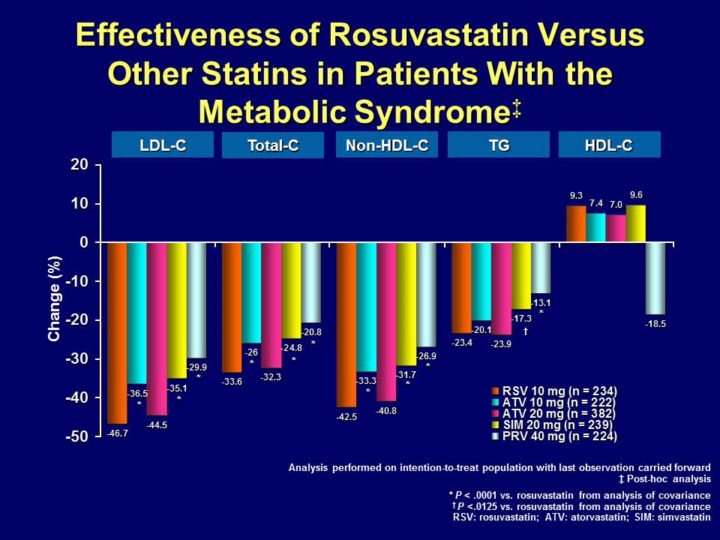| front |1 |2 |3 |4 |5 |6 |7 |8 |9 |10 |11 |12 |13 |14 |15 |16 |17 |18 |19 |20 |21 |22 |23 |24 |25 |26 |27 |28 |29 |30 |31 |32 |33 |34 |35 |36 |37 |38 |39 |40 |41 |42 |43 |44 |45 |46 |47 |48 |49 |50 |51| 52 |53 |54 |55 |review |
 |
The analysis of the current slide compares the effects of statin therapy on plasma lipid levels in hypercholesterolemic patients with the Metabolic Syndrome using the patients included in the Measuring Effective Reductions in Cholesterol Using Rosuvastatin TherapY I (MERCURY I) trial.1
This trial compared rosuvastatin 10 mg with atorvastatin 10 mg and 20 mg, simvastatin 20 mg and pravastatin 40 mg over 8 weeks in patients with coronary or other atherosclerotic diseases or diabetes who had fasting levels of LDL-C of at least 2.99 mmol/l (>115 mg/dL) and triglycerides of <4.52 mmol/L ( < 400 mg/dL).1
The patients used in this analysis were those that met the modified National Cholesterol Education.
Program Adult Treatment Panel III criteria for the the Metabolic Syndrome (n=1342)1.
Reductions in LDL-C, total cholesterol, and non-HDL-C were significantly greater with rosuvastatin 10 mg, compared to other treatments except atorvastatin 20 mg. All treatments produced reductions in triglycerides and increases in HDL-C.2
References: 1. Schuster H et al. Effects of switching statins on achievement of lipid goals: measuring effective reductions in cholesterol using rosuvastatin therapy (MERCURY I) study. Am Heart J. 2004; 147: 705–712. 2. Stender S. Comparison of rosuvastatin with atorvastatin, simvastatin and pravastatin in achieving cholesterol goals and improving plasma lipids in hypercholesterolemic patients with or without the metabolic syndrome in the MERCURY I trial* Diabetes, Obesity and Metabolism. 2005;7:430–438. |